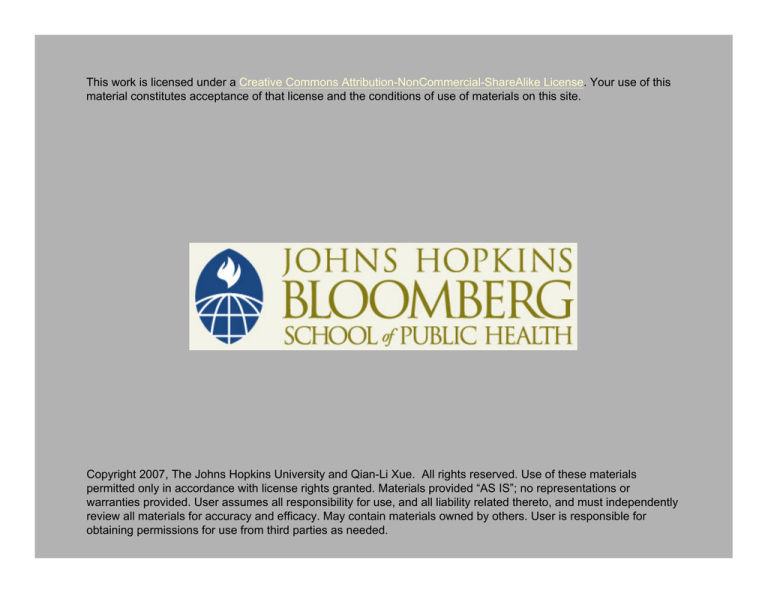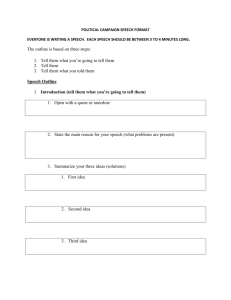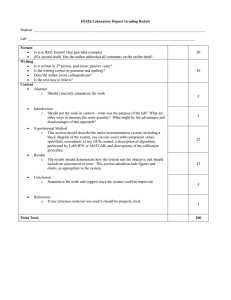
This work is licensed under a Creative Commons Attribution-NonCommercial-ShareAlike License. Your use of this
material constitutes acceptance of that license and the conditions of use of materials on this site.
Copyright 2007, The Johns Hopkins University and Qian-Li Xue. All rights reserved. Use of these materials
permitted only in accordance with license rights granted. Materials provided “AS IS”; no representations or
warranties provided. User assumes all responsibility for use, and all liability related thereto, and must independently
review all materials for accuracy and efficacy. May contain materials owned by others. User is responsible for
obtaining permissions for use from third parties as needed.
Introduction to Structural
Equations
Statistics for Psychosocial Research II:
Structural Models
Qian-Li Xue PhD
Assistant Professor of Medicine, Biostatistics,
Epidemiology
Johns Hopkins Medical Institutions
Course Overview
(1) Structural Regression/Path Analysis
(a) “effect mediation” versus “controlling for”
(b) causality
Course Overview: Structural Equation
Models with Observed Variables
ζ3
x1
ζ2
y3
y2
x2
ζ1
y1
(McDonald and Clelland, 1984)
Study Aim: union sentiment
among southern nonunion
textile workers
y1 – deference to managers
y2 – support for labor activism
y3 – sentiment toward unions
x1 – years in textile mill
x2 – age
Course Overview: Structural Equation
Models with Latent Variables
(2) Regression plus measurement
(2) structures from last term
(a) if we ignore measurement, “item regression”
(b) factor analysis: structural equations with latent
variables
(c) latent class analysis: latent class regression
Course Overview:
Structural Equations = Structural + Measurement Components
symptoms
treatment
T
depression
β
η
λ1
λ2
Ym
ε1
ε2
…
λm
Y2
…
ζ
Y1
εm
Structural Component
Measurement Component (1st Term)
12
10
8
SOCIOECONOMIC STATUS
6
4
How does outcome
vary with predictors?
Make inference on
hypothesis about how
predictors affect
outcome
Predict individual
outcomes
14
General Idea
8
10
12
EDUCATION
14
16
Challenge
How do we measure latent outcomes (and
predictors)?
There are multiple responses
Approach 1:
Y1,…,Yn measure the same thing. Treat individually or
summarize Y’s.
Approach 2:
Call ideal outcome η
If we knew η, then ηi = β0 + β1X1i + β2X2i + ...
But we don’t know it:
infer η from factor analysis or latent class analysis
regress η on X’s
Three approaches to assessing association
between covariates and multiple responses
(1) Summarize Then Analyze (STA)
(2) Analyze Then Summarize (ATS)
(3) Summarize AND Analyze: (SAA)
Structural Equations
2 parts
measurement
component
structural/regression component
Example: Depression Study
Summarize then Analyze (STA)
Clinical trial of two antidepressants
Which anti-depressant is
more effective for treating
depression?
Depression symptoms
were based on the
Hamilton Depression
Rating Scale (HAM-D).
17 Symptoms
•
•
•
•
•
•
•
•
•
•
Depressed mood
Guilt feelings
suicide
Insomnia (x3)
Work and activities
Psychomotor retardation
agitation
anxiety
Somatic symptoms
…..
For each item, write the correct number on the line next to the item. (Only one response per item)
_____1. DEPRESSED MOOD (Sadness, hopeless, helpless, worthless)
0= Absent
1= These feeling states indicated only on questioning
2= These feeling states spontaneously reported
3= Communicates feeling states non-verbally—i.e., through facial expression, posture, voice, and tendency
to weep
4= Patient reports VIRTUALLY ONLY these feeling states in his spontaneous verbal and non-verbal
communication
_____2. FEELINGS OF GUILT
0= Absent
1= Self reproach, feels he has let people down
2= Ideas of guilt or rumination over past errors or sinful deeds
3= Present illness is a punishment. Delusions of guilt
4= Hears accusatory or denunciatory voices and/or experiences threatening visual hallucinations
_____3. SUICIDE
0= Absent
1= Feels life is not worth living
2= Wishes he were dead or any thoughts of possible death to self
3= Suicidal ideas or gesture
4= Attempts at suicide (any serious attempt rates 4)
_____4. INSOMNIA EARLY
0= No difficulty falling asleep
1= Complains of occasional difficulty falling asleep—i.e., more than ½ hour
2= Complains of nightly difficulty falling asleep
_____5. INSOMNIA MIDDLE
0= No difficulty
1= patient complains of being restless and disturbed during the night
2= Waking during the night—any getting out of bed rates 2 (except for purposes of voiding)
_____6. INSOMNIA LATE
0= No difficulty
1= Waking in early hours of the morning but goes back to sleep
2= Unable to fall asleep again if he gets out of bed
Example:
Summarize then Analyze (STA)
Summarize:
Add up the number of symptoms, or “score” the HAMD.
Treat the score as “fixed” or “observed” outcome.
But, we know better! It is not measured perfectly.
What is the reliability of the HAM-D???
Analyze: See how the outcome relates to
predictor (i.e., treatment)
Summarize Then Analyze
1. Sum up HAM-D score pre and post and take
difference:
Pre-treatment score:
Yi1 = Yi1,1 + Yi1,2 + L+ Yi1,21
Post-treatment score:
Yi 2 = Yi 2 ,1 + Yi 2 ,2 + L+ Yi 2 ,21
Difference:
Di = Yi 2 − Yi1
2. Evaluate association with Yi and treatment
Di = β0 + β1trti
where trti = 1 of treatment A, and 0 if treatment B
3. Make inference about treatment effect based
on β1
STA: Two models estimated separately
Y1
Y2
Model 1:
S(Y)
.
.
.
.
Summary of Y’s
Ym
Model 2:
β1
T
“treatment”
S(Y)
STA: so what is the problem???
We are ignoring that S(Y) is measured with
error.
Note that that S(Y) has reliability less than 1.
In our example: S(Y) represents an “imperfect
measure” of depression with reliability of about
0.88 (depending on population).
Aren’t we then overestimating the variation in
our outcome by using S(Y)?
Recall: Var(Tx) < Var(X), Tx is the true score of x
What effect might that have on the standard
error of β1?
The Consequences of
Measurement Error
x = ξ +δ
True Model:
y =η +ε
η = γξ + ζ
(a) True Model
ξ
1
γ
ζ
(b) Estimated Model
ζ*
η
1
γ*
X
X
Y
δ
ε
Y
Bollen, 1989: p155
The Consequences of
Measurement Error
True Model:
x = ξ +δ
y =η +ε
η = γξ + ζ
cov(ξ ,η ) = cov(ξ , γξ + ζ ) = γφ
cov( x, y ) = cov(ξ + δ ,η + ε ) = γφ
⎡ φ ⎤
cov( x, y )
γ =
=γ⎢
= γρ xx
⎥
var( x)
⎣ var( x) ⎦
ρ xx = reliability coefficient
Note: γ Is not
Therefore, | γ * | < | γ |
affected by ρyy!
*
The Consequences of
Measurement Error
ξ +δ
y =η +ε
η = γξ + ζ
True Model: x =
ρξη =
ρ xy
ρ xx ρ yy
Also, it can be shown that
correction for attenuation
ρ xy2 = ρ xx ρ yy ρξη2
of correlation coefficient
i.e. the squared correlation between the two observed
measures is attenuated relative to the latent variables
whenever the reliability of x or y is less than 1!
The Consequences of
Measurement Error
In the case of multiple regression, the following is no
longer true
*
|γ |<|γ |
However, the following still holds:
*2
R ≥R ,
2
2
*2
where R and R are the squared mulitple correlatio n
coefficent s for the regression s containing variables
without and with measuremen t error, respective ly.
Another Approach:
Analyze Then Summarize (ATS)
1. Analyze: for each of the 21 items in the HAMD, see if treatment is associated with
improvement.
1. Define outcome per item:
2. Estimate association per item
with treatment:
Di ,1 = Yi 2 ,1 − Yi1,1
Di ,1 = β0,1 + β1,1trti
M
Di ,2 = β0,2 + β1,2 trti
Di ,21 = Yi 2 ,21 − Yi1,21
M
Di ,21 = β0,21 + β1,21trti
Another Approach:
Analyze Then Summarize (ATS)
0.0
-0.5
-1.0
-1.5
-2.0
Beta and 95% CI for beta
0.5
2. Summarize: Qualitatively or quantitatively
evaluate the associations
5
10
Item Number
15
20
Analyze then Summarize
β1
T
Y1
β2
Y2
βm
.
.
.
Ym
Fit m regressions to individually describe association
between T and each Y.
Then summarize associations.
So what is wrong with ATS?
How do we answer the question: “Which
treatment works better?”
We get individual answers.
Often hard to summarize after the analysis
has been done.
(More about this in ‘Item Regression
lecture’)
Summarize and Analyze
Simultaneously (SAA)
Fit ‘summarize’ and ‘analyze’ components at the same
time.
One big model
Accounts for measurement error via latent variable
T
β
η
λ1
λ2
λm
Y1
Y2
…
Ym
Summarize and Analyze Simultaneously
symptoms
treatment
T
depression
β
η
λ2
Y2
Ym
ANALYZE
(“Structural”)
SUMMARIZE
(“Measurement”)
ε1
ε2
…
λm
Y1
…
ζ
λ1
εm
Summarize and Analyze Simultaneously
symptoms
treatment
T
depression
β
η
λ2
Y2
Ym
Example:
η = βT + ζ
…
Y1 = λ1 η + ε1
Y2 = λ2 η + ε2
Ym = λm η + εm
ε1
ε2
…
λm
Y1
…
ζ
λ1
εm
Path Notation
ε1
ε2
ε3
Y1
Y2
Y3
circles vs. squares
exogenous (independent)
endogenous (dependent)
Errors
ξ
X1
δ1
straight arrow (causal)
curved arrow (unspecified)
Variables
ζ
η
Relationships
X2
δ2
X3
δ3
one for every endogenous
variable
unexplained component of
predicted variables
Components of Structural Equation Model
(A) Measurement Piece
how latent variable related to “surrogates”
comprised of η’s and Y’s
λ1
η
λ2
ε1
Y2
ε2
Ym
…
…
λm
Y1
εm
Components of Structural Equation Model
(B) Structural Piece
how latent variable is related to its predictors
regression
comprised of η’s and T
T
β
η
ζ
Components of Structural Equation Model
(C) Both components are fit in ONE step
Why better? Does not assume η (i.e., “summary” of
Y’s) known, which acknowledges measurement error.
Why bad? If model is misspecified, then inference is
misleading.
T
β
λ1
η
Ym
ε1
ε2
…
λm
Y2
…
ζ
λ2
Y1
εm
Statistical way of considering relationship
between T and Y
P(Y = y | T ) =
R
∑ P(Y = y,η = r | T )
r =1
=
R
∑ P(Y = y | η = r , T ) P(η = r | T )
r =1
T
β
λ1
η
Ym
ε1
ε2
…
λm
Y2
…
ζ
λ2
Y1
εm
Assumption 1: Non-Differential
Measurement
Equivalent interpretations:
covariates do not predict observed
responses after controlling for latent status
no arrows between T and Y’s
Y and T independent given η
P (Y = y | η , T ) = P (Y = y | η )
NOT OK UNDER NON-DIFFERENTIAL
MEASUREMENT:
Y1
λ1
χ
T
ζ
Ym
ε2
…
λm
Y2
…
β
η
λ2
ε1
εm
Assumption 2: Local/Conditional
Independence
Equivalent Interpretations
latent variable explains all association
between observed variables
no arrows among measurement errors
observed variables are independent given
η
P(Y1 = y1 , Y2 = y2 | η) = P(Y1 = y1 | η) P(Y2 = y2 | η)
NOT OK UNDER CONDITIONAL INDEPENDENCE:
T
β
λ1
η
Ym
ε1
χ
ε2
…
λm
Y2
…
ζ
λ2
Y1
εm





